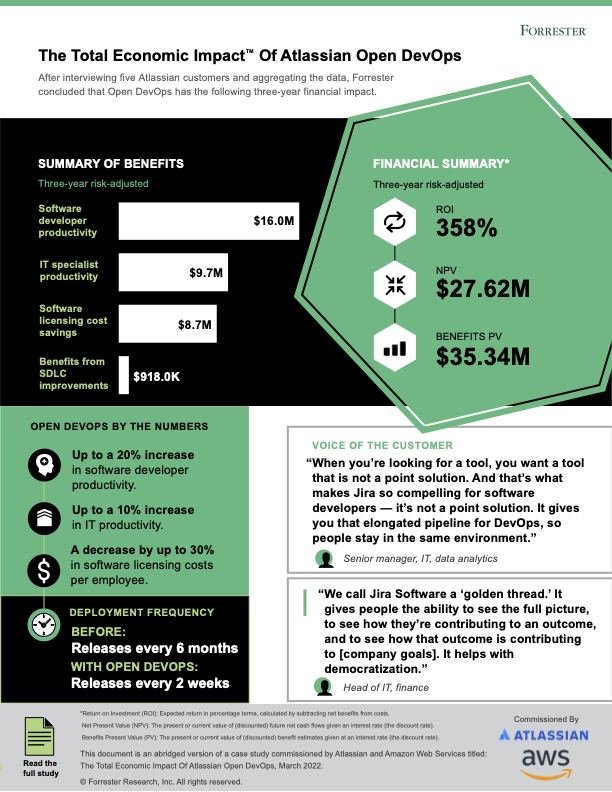Atlassian Open DevOps could net teams a potential ROI of 358%
Forrester Consulting’s Total Economic Impact Study found that Atlassian Open DevOps helps save time by automating repetitive and low-value tasks.
For developer and operations teams that need to work together collaboratively throughout the product life cycle, a good DevOps process is key. Under a DevOps model, these teams create close bonds and strong practices through automation and tools. But establishing that collaboration is no quick endeavor. It’s a transformation that takes time, cooperation, adherence to best practices, and the right set of tools.
We had all of the standard tools for collaboration, but not necessarily the processes. […] Different teams were doing things different ways and with different tooling. [As a result], reporting, dashboards, and delivery were really hard. It was really chaotic. There was no planning and governance.
Senior manager in IT
What is Open DevOps?
DevOps toolchains usually follow one of two approaches – an all-in-one tool or an open toolchain. An all-in-one toolchain offers a complete solution that usually doesn’t integrate with other third-party tools, while an open toolchain allows for integration and customization with different tools. Last year, we announced our new Open DevOps product – a pre-configured Jira project combined with Confluence, Bitbucket, Opsgenie, and your favorite third-party tools. Our Open DevOps solution allows organizations to use their chosen tools while still centralizing and coordinating in Jira Software.
Open DevOps saves time
Forrester Consulting recently conducted a Total Economic Impact Study that shows the impact of teams using Atlassian Open DevOps. In this study, commissioned by Atlassian and AWS, five different Open DevOps customers were interviewed to understand the effect on their organizations.
When you’re looking for a tool, you want a tool that is not a point solution. And that’s what makes Jira so compelling for software developers – it’s not a point solution. It gives you that elongated pipeline for DevOps, so people stay in the same environment.
Senior manager in IT
Customers found that Open DevOps had a huge impact on their productivity. Before using Open DevOps, the software and IT teams struggled to collaborate. They had no standard tooling or processes, and as a result, worked in silos with low visibility. Each team had different tools with different ways of working, which led to disconnecting toolchains across the company. The tool proliferation and silos across teams led to problems like low collaboration, and the rise of new tools caused bottlenecks for IT teams as they struggled to support the additional tools.
After adopting Open DevOps, the organizations reported that integrating Jira Software with their toolchains allowed them to automate repetitive and low-value tasks that helped them save 1.5 hours per developer each day. Those productivity savings also extended to IT, where connected toolchains gave IT specialists improved visibility and reduced maintenance efforts due to curbed tool proliferation. The study shows that Open DevOps gives teams the ability to focus on high-value work and improve productivity across the board. Overall, it represents a potential return on investment (ROI) of 358% over a three-year period.

Forrester Consulting’s Total Economic Impact Study showed that Open DevOps delivered increased productivity for IT and software developers, reduced software costs due to retired and redundant tooling, and increased deployment frequencies to biweekly (or faster). Dive deeper into the study by downloading it below.

